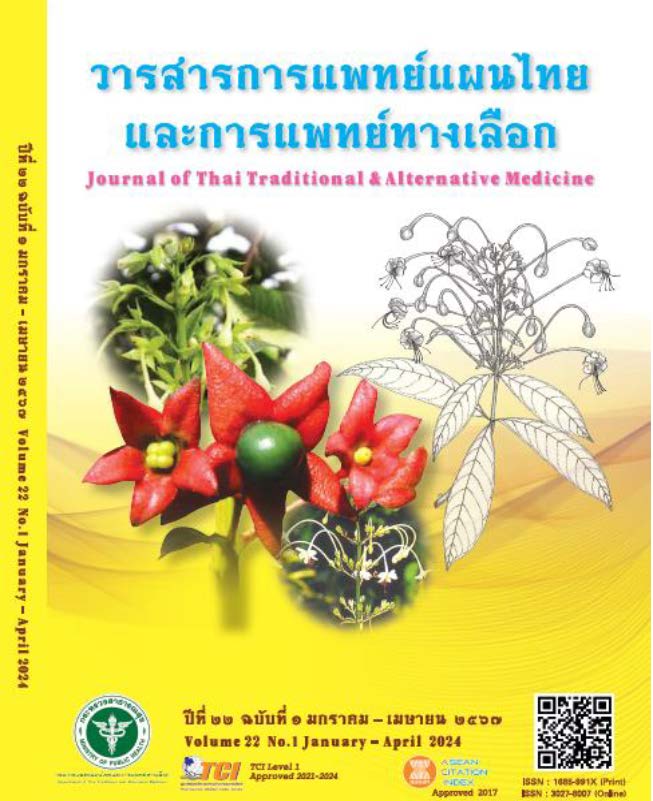The Evaluation of Chemical and Physico-Chemical Properties of Mitragyna speciosa (Korth.) Havil. Leaves
Main Article Content
Abstract
Introduction and objective: Mitragyna speciosa (Korth.) Havil., commonly known as kratom, belongs to the family Rubiaceae. Kratom leaves have medicinal properties for relieving stomach pain and body aches, curing dysentery and diarrhea, and tranquilizing the body. However, the standard methods for quality control of this plant have not been established in the Thai Herbal Pharmacopoeia. Therefore, the aim of this study was to investigate the chemical and physico-chemical properties of M. speciosa leaves.
Methods: Seventeen samples of M. speciosa leaves were obtained from many provinces throughout Thailand and compared to the authentic sample received from the Herbarium Laboratory. The samples of M. speciosa leaves were preliminarily examined for chemical properties using color reaction. Chemical identification was performed using the thin layer chromatography (TLC) method and their chemical and physico-chemical properties were also determined.
Results: All 17 M. speciosa leave samples, based on the color reactions of the preliminary examination, were positive for alkaloids, flavonoids and phenolics; and based on the TLC method, they were positive for alkaloids including mitragynine. As for their chemical and physico-chemical properties, shown as mean ± SD, the moisture, total ash, acid-insoluble ash, water-soluble extractive and ethanol-soluble extractive contents were 5.60 ± 0.68%, 4.67 ± 0.37%, 0.14 ± 0.02%, 19.52 ± 1.68% and 17.12 ± 2.81% w/w, respectively.
Discussion: The examination of chemical and physico-chemical properties and the verification of the chemical identity of M. speciosa leaf raw materials are beneficial for controlling chemical quality to meet the criteria for standardizing herbal medicines and to ensure their good quality and consistency for effective consumption.
Conclusion and recommendation: The results of this study have led to the establishment of a monograph and the standardization of dried M. speciosa leaves in the Thai Herbal Pharmacopoeia to be used as a reference standard of Thailand.
Article Details

This work is licensed under a Creative Commons Attribution-NonCommercial-NoDerivatives 4.0 International License.
References
เอกสารอ้างอิง
Boonyaprapat N, Chokchaicharoenporn O. Medicinal Plants indigenous to Thailand. Bangkok: Prachachon; 1996. 1(1): p. 54-55. (in Thai)
Wungsintaweekul J. Kratom [Internet]. Nonthaburi: Center for Continuing Pharmacy Education. The Pharmacy Council; [cited 2019 July 24]. Available from: https://ccpe.pharmacycouncil.org/index.php? option=article_detail&subpage=article_detail&id= 251
Panyaphu D, Namkeard S, Inchai W, Yossathera K. Kratom: Herbal Medicine or Narcotic Drug. J Thai Trad Alt Med. 2016; 14(3): 242-56. (in Thai)
Field E.J. Mitragynine and mitraversine, two new alkaloids from species of Mitragyna. Transaction of the Chemical Society. 1921; 119: 887-891.
Hooper D. The anti-opium leaf. Pharmaceutical Journal. 1907; 78: 453.
Lee C.M., Trager W.F., Beckett A.H. Corynantheidine-type alkaloids- II: absolute configuration of mitragynine, speciociliatine, mitraciliatine and speciogynine. Tetrahedron. 1967; 23(1): 375-385.
Ponglux D, Wongseripipatana S, Takayama H, Kukuchi M, Kukihara M, Kitayama M, Aimi N and Sakai S. A new indole alkaloid, 7 alpha-hydroxy-7H-mitragynine, from Mitragyna speciosa in Thailand. Planta Med. 1994; 60: 580-581.
Farah Idayu, N. Taufik Hidayat, M. Moklas, M.A.M. Sharida, F. Nurul Raudzah, A.R. Shamina, A.R. Apryani E. Antidepressant-like effect of mitragynine isolated from Mitragyna speciosa Korth in mice model of depressant. Phytomedicine. 2011; 18(5): 402-407.
Osman ME, Ahmed EM, Eltohami MS. Preliminary phytochemical evaluation and seed proximate analysis of Surib (Sesbania leptocarpa DC.). Sudan JMS 2013; 8 (1): 29-34.
Department of Medical Sciences. Thai Herbal Pharmacopoeia. Volume II. Bangkok: Prachachon;2007.
Ahuja J, Suresh J, Deep A, Madhuri, Pratyusha, Ravi. Phytochemical screening of aerial parts of Artemisia parviflora Roxb.: A medicinal plant. Pharm Lett 2011; 3: 116-24.
Department of Medical Sciences, Ministry of Public Health. Thai Herbal Pharmacopoeia. Volume I. The Agricultural Cooperative Federation of Thailand Limited. 2016.
Department of Medical Sciences, Ministry of Public Health. Thai Herbal Pharmacopoeia 2018. Bangkok: Keawjawjom Printing & Publishing SuanSunandhaRajabhat University; 2018.
Plant Research and Development Division. Inspection methods to control quality and standardization. In: Herbal Guide to Basic Public Health. Department of Medical Sciences, Bangkok. Text and Journal Corporation Co., Ltd., 1988, 17-9. (in Thai)
Evans W.C. Trease and Evans’ Pharmacognosy. 13th ed. London: ELBS, 1989. pp. 39-57, 127-9.
Department of Medical Sciences, Ministry of Public Health. Thai Herbal Pharmacopoeia. Volume I. Bangkok: Prachachon Co. Ltd., 1995.
Department of Medical Sciences, Ministry of Public Health. Thai Herbal Pharmacopoeia. Volume II. Bangkok: Prachachon Co. Ltd., 2000.
Dechatiwongse Na Ayudhya T, Jirawattanapong W. Standardization and quality control of herbs. Medicinal Plant Research Institute, Department of Medical Sciences, Nonthaburi, 2001: 1-25. (in Thai)
Drug Control Division, Food and Drug Administration. Guidelines for quality control of medicinal products from herbs. Bangkok: Agricultural Cooperative Assembly Printing Company of Thailand Limited, 2005.


